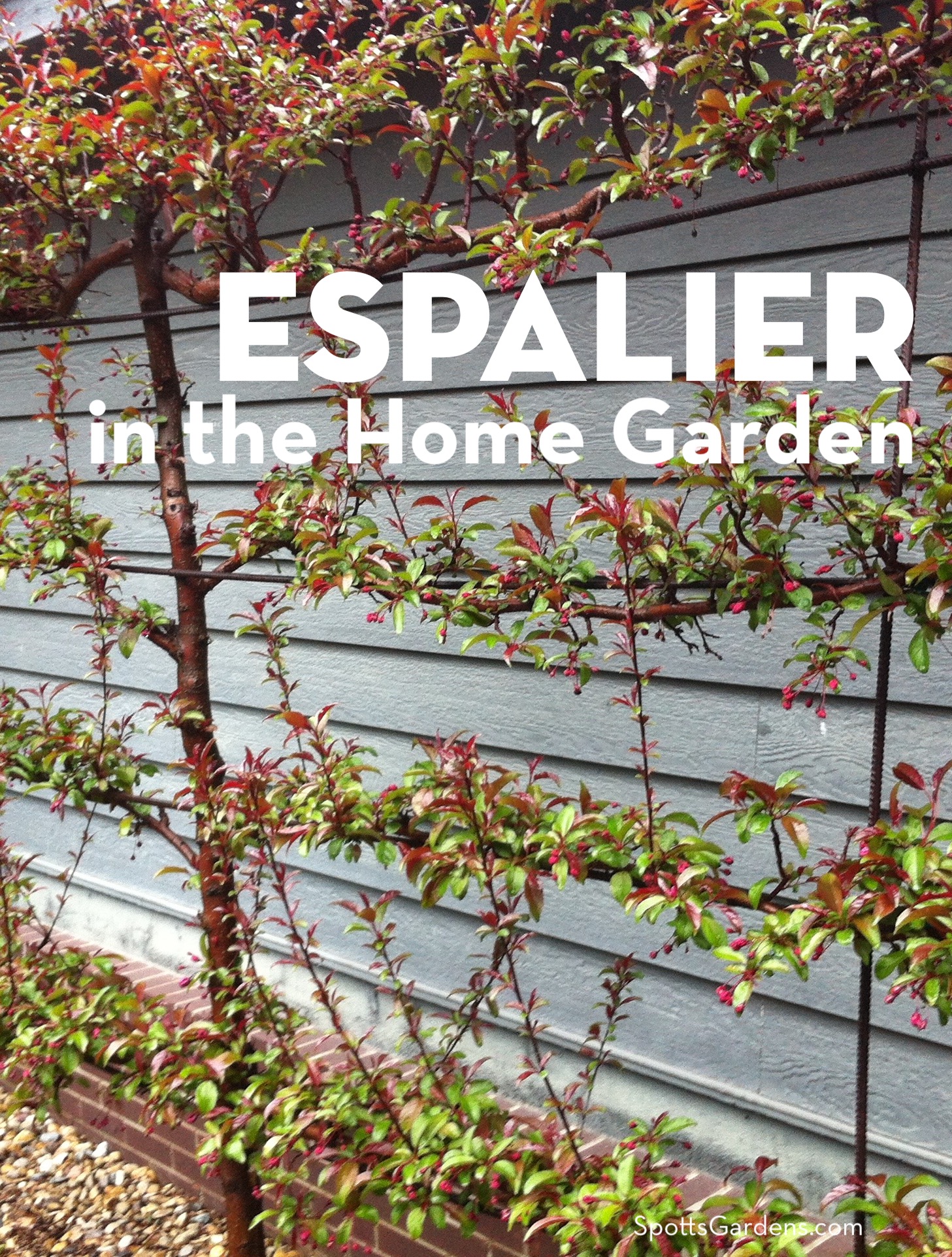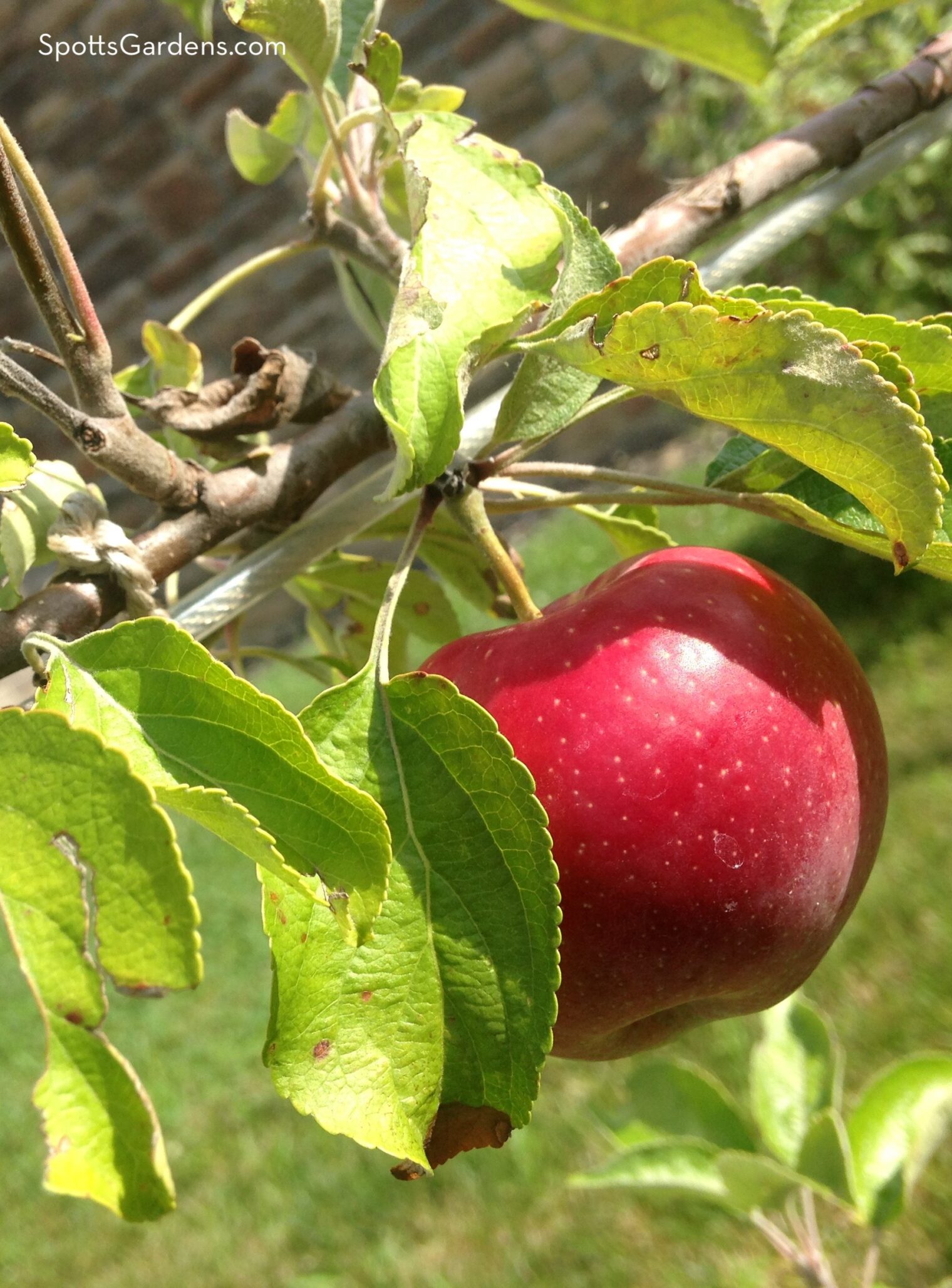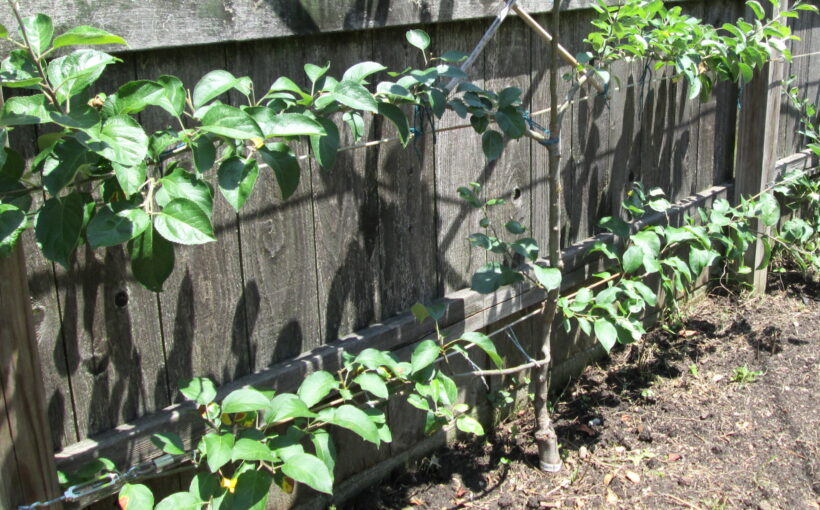Espalier (es-PAL-yay) is the art of growing trees in two dimensions. Fruit or ornamental trees are trained to grow flat against walls, fences, or trellises, and are shaped into specific forms. With careful attention, fruit trees trained this way trees can turn out more fruit per square foot than freestanding trees.
We like to use espalier in small gardens to maximize fruit production and in formal gardens as a design element or focal point. Training and maintaining these trees is a high-maintenance technique that requires pruning at least twice a year. So if you’re looking for a low-maintenance garden, espalier isn’t a good choice!
The Cordon Forms For Apples and Pears
Classical espalier falls into several traditional forms. Of these forms, the easiest for a home gardener to use is the cordon, and the best fruits for the cordon are apples and pears.
In a cordon, the tree is trained to a single stem, which can be upright or at an angle. A cordon may have no branches and be grown at an angle, in which case you can pack a lot of cordons into one space and use it as a nearly opaque divider in the garden. Or it can have branches in a single tier (a “step-over”) or multiple tiers.

We’re fans of the multi-tiered cordon (also, confusingly, called the “espalier” form; seen above), which can be used to create a divider in the garden or a hedge against a wall. In this form, pairs of horizontal arms come off the single, center trunk, with each pair creating a tier.
Stone fruits, like peaches or plums, require different forms than apples and pears do. They are commonly pruned to a fan shape.
While you can buy trees that have already been pruned into an espalier, you have a much wider range of fruit varieties to choose from if you create your own.
Understanding How Espaliered Trees Grow
To create an espalier form, it helps to understand how the shoots (one-year-old growth) on a tree grow:
- Trees grow from the tip buds at the end of each shoot of new growth. That tip bud represses the dormant (inactive) buds below it from developing.
- If you remove the tip bud, all the growth hormones that were going to that tip will instead force the dormant buds right below it to start developing into shoots. Those shoots are laterals.
- A vertical shoot will grow very fast from the tip.
- A shoot growing at 45-degrees will still grow from the tip, but not as fast as a vertical shoot.
- A horizontal branch will grow very little if at all from the tip. Instead, the dormant buds all along the vertical will develop into new shoots.
To create an apple or pear espalier, choose a variety that is spur bearing. That means that its fruits develop on stubby little lateral shoots called spurs. The goal of the espalier is to restrict the growth of the tree to 2-dimensions while producing lots of spurs. See Chicago Botanic Garden for more.

Creating a Multi-Tiered Cordon Espalier
We prefer to use apple and pear trees (both European and Asian) on dwarfing or semi-dwarfing rootstock.
1. Create the Supports (Year 1; late winter)
- Sink fence posts to act as supports 6’ to 8’ apart (depending on your tree). String wire supports between your posts with wires set parallel to the ground and about 15” to 18” apart.
2. Plant the Tree (Year 1, late winter)
- Start with a 1-year-old tree, preferably with few or no branches (also called a “whip” or “maiden whip.”) Plant it in the dormant season, at least 8″ away from a wall or fence to ensure good air circulation.
In central Indiana, planting is usually between mid-February and mid-March, before the tree has leafed out.
3. Cut Back Hard (Year 1, late winter)
- Right after you plant, prune the main trunk to the bud that is immediately below the first wire. It will look like a short stick at this stage. Put a stake behind the whip and tie it vertically to the wires. Then gently tie the whip to the stake.
Because you’ve removed the tip-bud, lateral shoots will develop from the buds right below the cut. After a season’s growth, one of those shoots will become the leader, or central stem of the tree. Two others will become your first set of horizontal arms.
4. Train the Leader and Laterals (Year 1; midsummer to late summer)
- By summer, several of the buds below the cut should be growing into laterals. Select the healthiest looking three. Choose which two will be the new side branches. The remaining one becomes your new leader.
- Tie the new leader to the center stake.
- Tie a bamboo stake to the wires at a 45-degree angle on either side of the trunk. Then gently tie a lateral to each.
You’re going to let these two lateral shoots grow at a 45-degree angle until they get as long as you want them. Then you can gently bend those lateral branches down and tie them to the first wire so they are parallel to the ground to create the horizontal arms.
It may take a year of growth for your laterals to get long enough, because branches growing at an angle don’t grow as fast as vertical shoots.
- If there are additional laterals on the center leader, cut them back to two or three buds each.
In central Indiana, we do this summer pruning after the summer solstice and no later than mid-September.

5. Create the Next Tier (Year 2, late winter)
- On the center leader, find a bud just below the second wire that faces the opposite direction of the cut you made last winter. Cut just above that bud.
- If your 45-degree laterals have grown long enough, gently bend them down and tie them to the wire horizontally to create the first set of horizontal arms.
- Remove any shoots growing from the trunk below the first two arms.
This dormant pruning is done after the worst of the freezing is over, but before the tree leafs out. In central Indiana, we dormant prune from about mid-February to mid-March.
6. Train the Leader and Laterals (Year 2, midsummer to late summer)
- Just as you did last summer, find the three strongest new laterals under the cut you made in winter. Tie one to the vertical stake to become the new leader. Tie the bamboo supports at 45-degree angles to either side, then tie the other two laterals to those supports.
- If you didn’t tie the old set of 45-degree laterals down to the horizontal wire in winter, do it now. Cut back any sublaterals or shoots growing off these arms to 3 leaves to encourage spurs to develop.
- Remove any shoots trying to develop below the established arms. Cut any other laterals developing off the leader to 3 leaves each.
- Repeat steps 5 and 6 until you have as many tiers as you want.
Growing Your Own
Espalier rewards patience and care, so plan for your espalier to take five to seven years to fruit. Get a good book to help guide your pruning. We like Grow Fruit, by Alan Buckingham.
We can help you choose, plant, train, and prune your espalier! Contact us today to discuss your options and get a free estimate.
